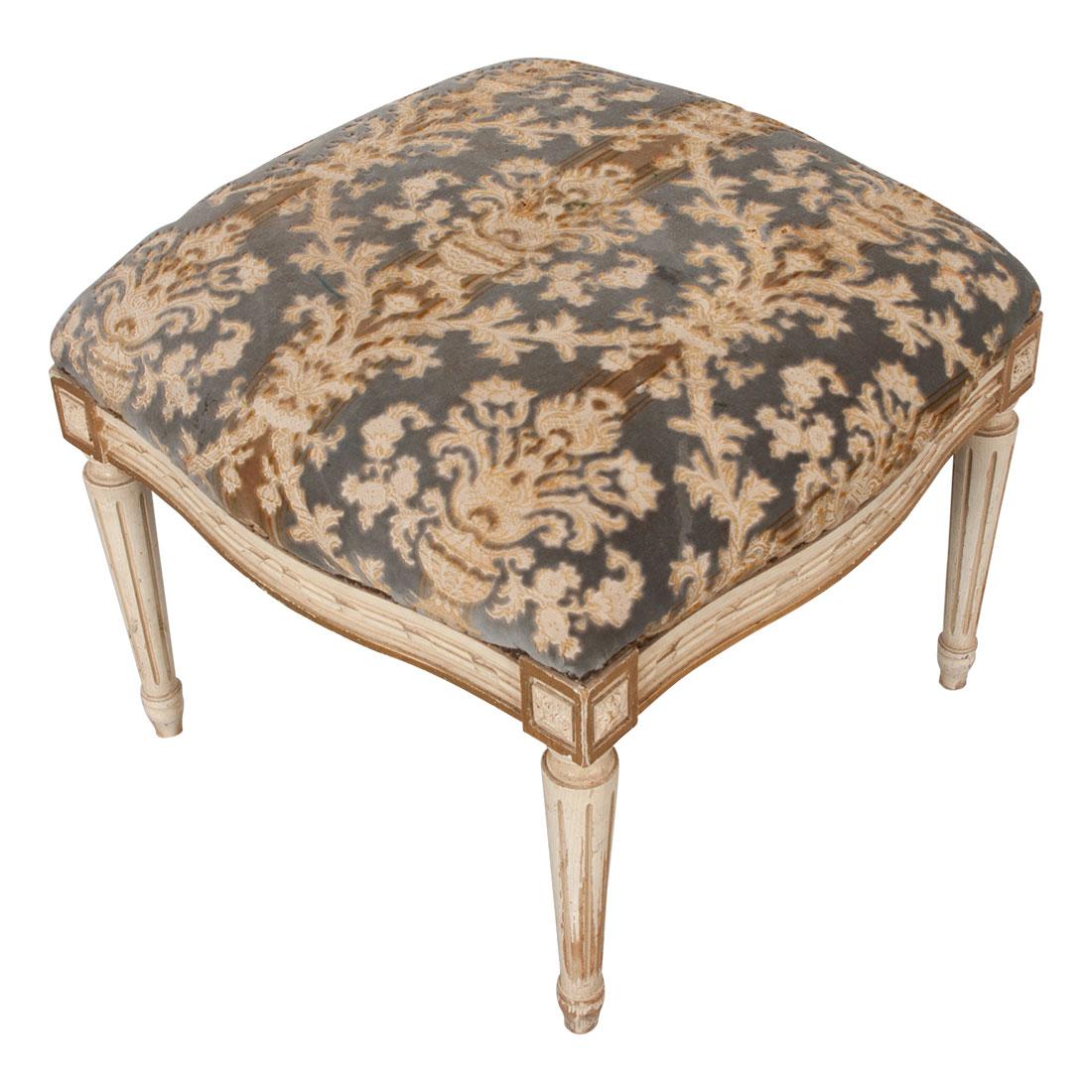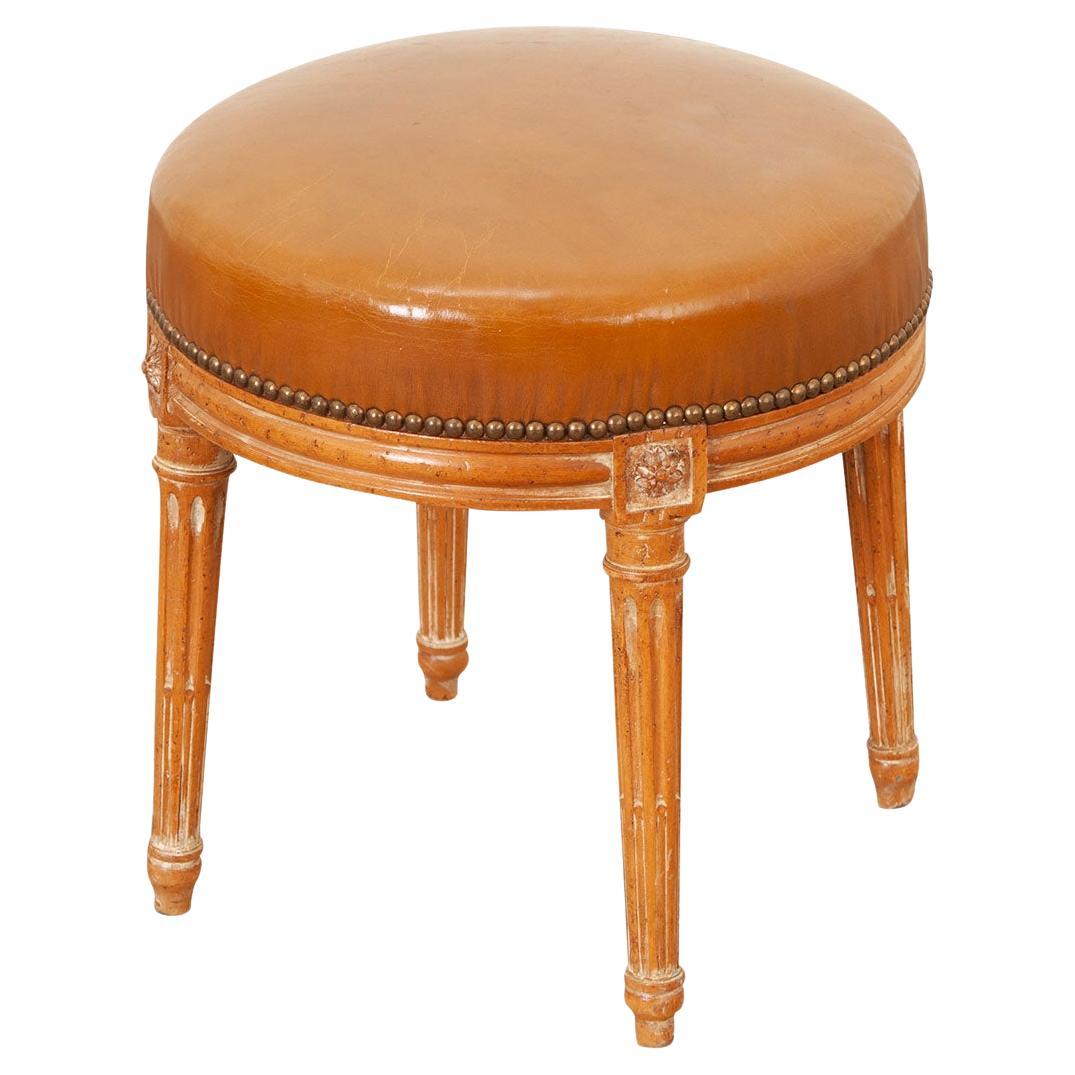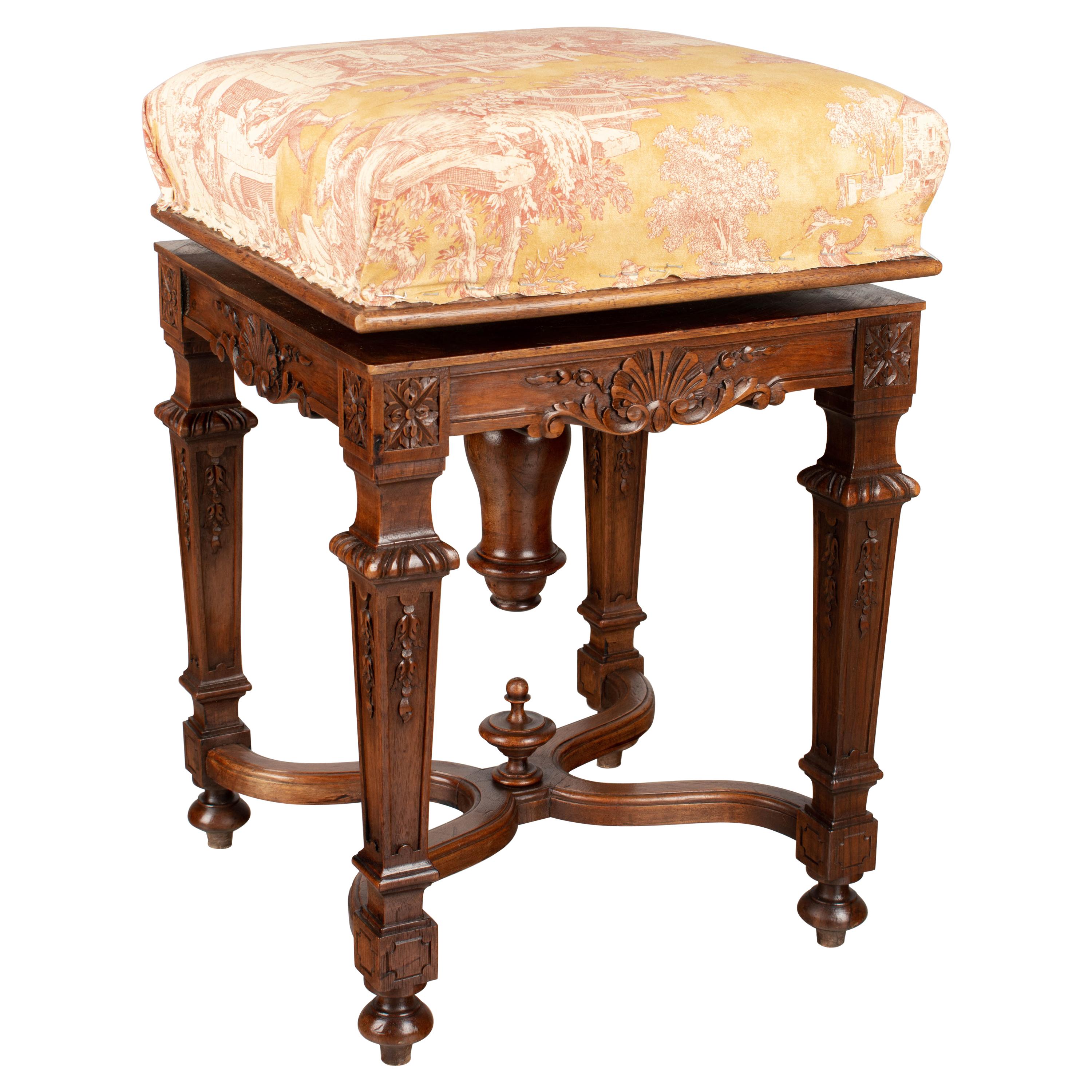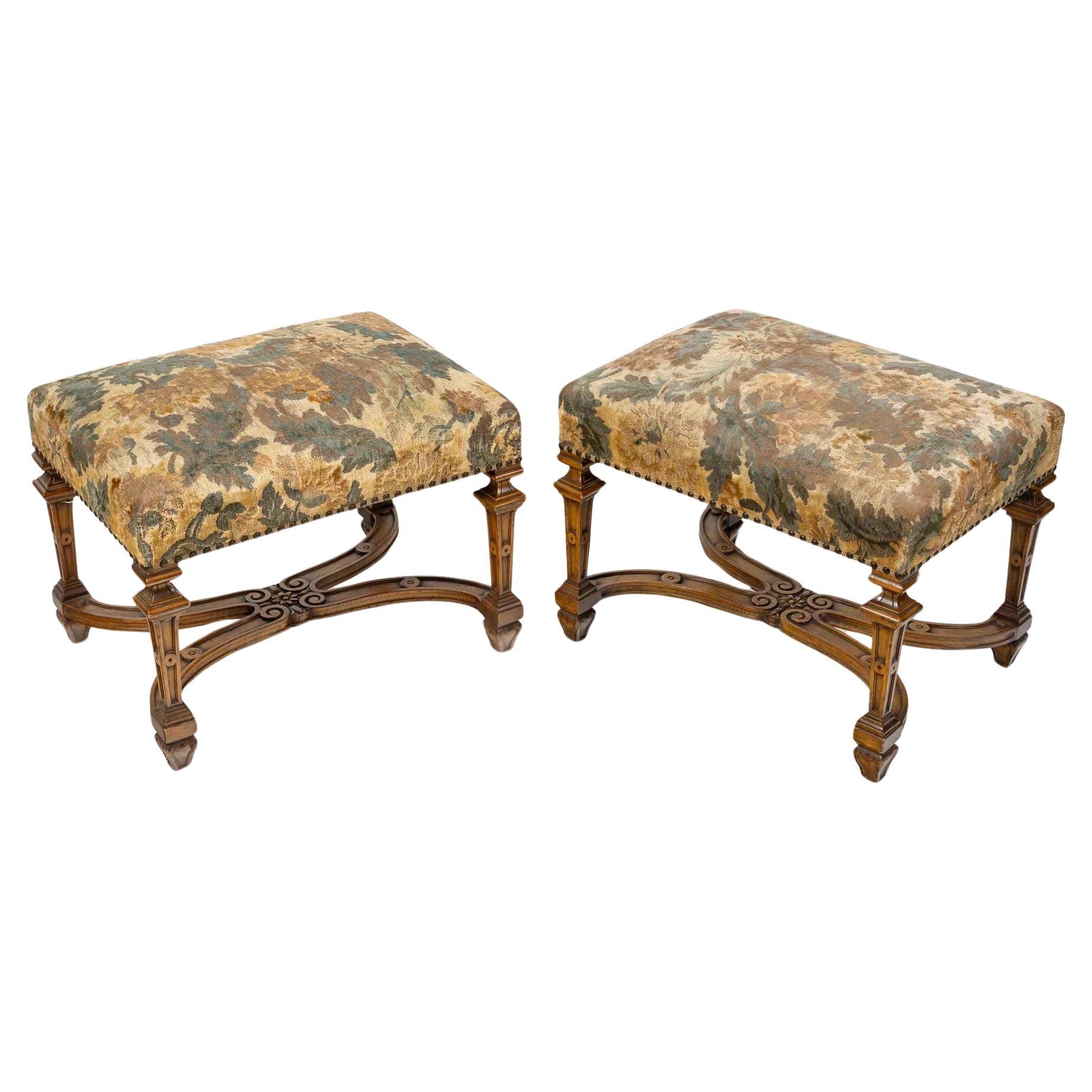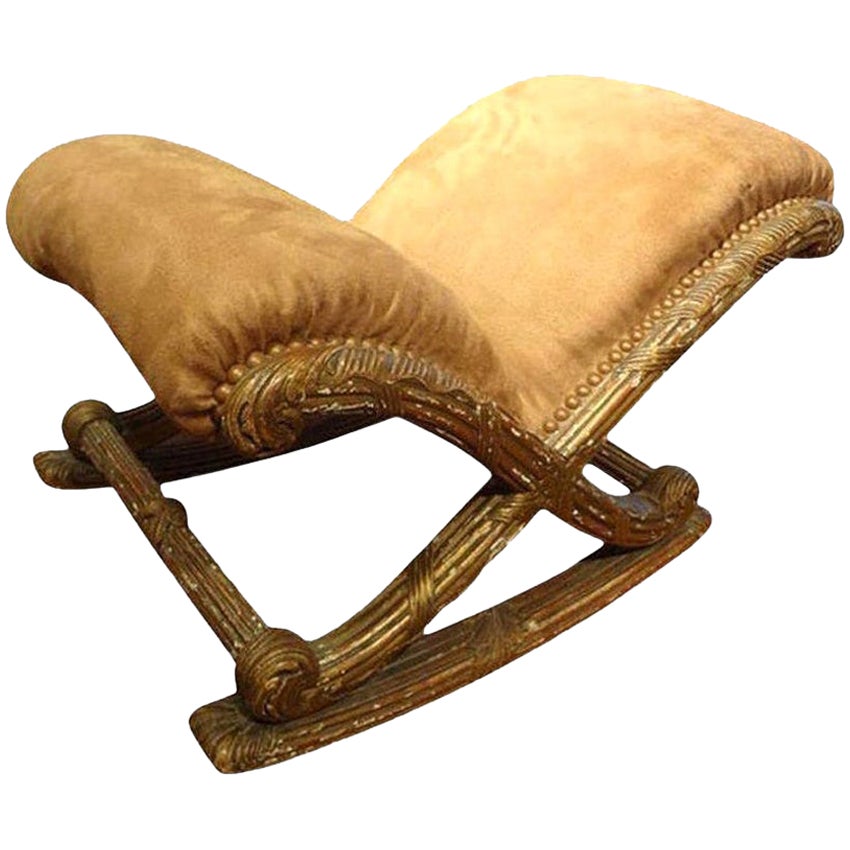Items Similar to A French 19th Century Pair of Louis XVI Style Large Curule Stools
Want more images or videos?
Request additional images or videos from the seller
1 of 8
A French 19th Century Pair of Louis XVI Style Large Curule Stools
About the Item
A French 19th Century Pair of Large Rectangular Curule Stools
Gilt and carved wood, decorated with interlace frieze, acanthus leaves and rosaces
The 4 feet linked by a gadrooned stretcher.
Louis XVI Style
Napoléon III Period
In the manner of Georges Jacob (1739-1814)
Attributed to Maison Jansen
Circa 1900
Used Petit Point Tapestry Upholstery
Maison Jansen, the French luxury:
Opulence, refinement, audacity of style marriages… so many words agree with Maison Jansen. Through this name, a whole era sounds like a reminder of a certain French chic…
Some names evoke immutable images, atmospheres... Like Jansen, for example. Let’s close our eyes… The 1960s and 1970s are at their peak. France is doing well. It is a country of full employment where everything seems possible. Within the international Jet Set, a carefree crowd of movie stars, public figures, literary idols and crowned heads, we love the Maison Jansen, its taste for styles struck with a good quality exuberance, and its brilliant side.
It all began in 1880, when the Dutchman Jean Henri Jansen founded the epon-ymous house in Paris. Jansen is part of the continuity of these world-famous furniture manufacturers and companies that operated under the Second Empire and at the time of the Universal Exhibitions, as the ‘Escalier de Cristal’ teaches. At that time, the Union Centrale des Beaux-Arts appliqués à l'Indus-trie and the Société du musée des Arts Décoratifs merged to form the Union Centrale des Arts Décoratifs.
Supported by both gallery owners, collectors and manufacturers, this organi-zation gives the «la» to the whole profession, and in the prevailing politico-ideological slump (France was defeated by Prussia in 1871 and Napoleon III is in exile), the ‘Union Centrale des Art Décoratifs’ focuses production on the celebration of past styles. While this nostalgia evokes memories of an era that we imagine more stable, an innovative exoticism will be all the rage: the reign of Turkish style and Japonisme.
The Jansen house masterfully rushed into the «exotic» trend, but quickly de-veloped a style derived from the ornamental splendor of the eighteenth, then a little later, so-called «imperial» styles mainly intended for royal families. Af-ter the First World War, J.H Jansen was joined by the cartoonist Albert Cazes, by Stéphane Boudin and by Pierre Delbée, who successively directed the house when it disappeared in 1929. At the end of the Kennedy era, Boudin complete-ly redecorated the White House, at the request of the First Lady, Jackie, who had fallen in love with his work after discovering it at Malmaison.
In 1971, Jansen joined forces with Leleu-Deshays and continued its quest for excellence. From 1969 to 1979, the dandy decorator Serge Robin took the reins of the house, granting it an eclectic and luxurious style: he revisited the great eras of French art, from the Renaissance to Louis XVI, by modernizing them with more contemporary pieces in Plexiglas or wrought iron. His recomposed and sophisticated style met with resounding success. When Jackie Kennedy, who became the wife of the great Greek shipowner Aristotle Onassis, moved to France, the young architect married Louis XVI-style furniture to modernist designs from the 1950s.
When the Shah of Iran decided to celebrate the 250th anniversary of the Per-sian Empire in 1971, Serge Robin and his teams turned to the grandiose and ephemeral setting of Persepolis. A hundred semi-trailers then left the work-shops on Rue Saint-Sabin to reach Tehran. At the same time, Princess Soraya of Iran commissioned her a sumptuous palace for Avenue Montaigne, the princes Faisal bin Fahd of Arabia and Mubarak Al-Sabah, and the Agnelli snatched it.
On the French side, he puts his talent at the service of Brigitte Bardot, for whom he completely revamped the Madrague and the Lannes boulevard.
Serge Robin embodies all the audacity of the name Jansen with the most im-probable weddings. With him, Plexiglas tables, Japanese chairs from the 50s, gold thread curtains, zebra sofas and leather Louis XVI style chests of drawers decorated the most fashionable apartments of the «seventies».
All the best stories have an end. At the dawn of the 1990s, weakened by the changes of a society plagued by concern, the disappearance or the remoteness of noble families, and the increasing scarcity of bourgeois residences, the Jan-sen house lost its aging clientele. The brand is missing the turn of modernity, and cannot adapt to changes in society, changing tastes, and the importance of design.
In 1989, it was closed. Jansen has not disappeared from the landscape: the house’s creations are still present on the market and in the French auction houses, but also in the United States, where they are very appreciated. Trans-parent Plexiglas tables, leather and metal armchairs, zebra sofas, exotic cabi-nets and chests of drawers in the Regency Style continue to find their place in some interiors, rekindling the flame of a time when we hoped for ever better tomorrow…
Georges Jacob is a French cabinet maker who produced an untold number of chairs from the reign of Louis XV to the Consulate. When he was an apprentice carpenter, he completed his journeyman internship with Louis Delanois, the supplier of the Comtesse du Barry. A fervent promoter of neoclassical sieges, Louis Delanois will exert an indisputable influence on Georges Jacob. Received master in 1765 he opened his workshop rue de Cléry then moved-in 1775 rue Meslée, thanks to a wealthy and royal clientele. In fact, requested from 1773 by the Garde-Meuble de la Couronne, he would not stop working for him until the Revolution. Georges Jacob is one of the official suppliers of Marie-Antoinette, but also of Monsieur, Count of Provence and brother of the King, future Louis XVIII, of the future Charles X, of the Prince of Condé, of the Duke of Penthièvre, as well as of the princes’ foreigners like the future Gustav III of Sweden and George IV of England.
An innovative cabinetmaker, he is often one step ahead of future trends and does not hesitate to imagine new decorations and new shapes of legs or seat arms such as connecting dice decorated with ro-settes, the finished console legs. at their top by a volute and the baluster-shaped armrest supports. The carved ornamentation of his furniture is abundant with recurring themes such as natural motifs of flowers and foliage, and friezes of foliage, piastres, ribbons, pearls, and interlacing. He was one of the promoters of English seats, with openwork backs inspired by Chippendale and Adam, as well as the initiator, from the Louis XVI period of the characteristic shapes of what we call today the Directoire style, inspired among other things by “Etruscan” furniture. While his friendship with the painter Jacques-Louis David enabled him to navigate the Revolution without a hitch, he quickly encountered other problems. In fact, in 1796 he sold his business to these two sons who thus founded “Jacob Frères” but unfortunately the eldest, Georges II, died in 1803. Georges Jacob father would then reconstitute with his second son François-Honoré-Georges a business, Georges Jacob senior died in his home rue Meslée in 1814.
- Attributed to:Maison Jansen (Cabinetmaker)
- Similar to:Georges Jacob (Cabinetmaker)
- Dimensions:Height: 17.72 in (45 cm)Width: 31.5 in (80 cm)Depth: 19.69 in (50 cm)Seat Height: 19.69 in (50 cm)
- Sold As:Set of 2
- Style:Louis XVI (In the Style Of)
- Materials and Techniques:
- Place of Origin:
- Period:
- Date of Manufacture:circa 1900
- Condition:Wear consistent with age and use.
- Seller Location:Saint-Ouen, FR
- Reference Number:1stDibs: LU2612338446502
About the Seller
4.9
Vetted Seller
These experienced sellers undergo a comprehensive evaluation by our team of in-house experts.
1stDibs seller since 2017
56 sales on 1stDibs
Typical response time: 1 hour
- ShippingRetrieving quote...Ships From: Saint-Ouen, France
- Return PolicyA return for this item may be initiated within 2 days of delivery.
More From This SellerView All
- A French 19th Century Pair of Louis XIV Style StoolsLocated in Saint-Ouen, FRA French 19th Century Pair of Large Rectangular Stools natural and carved wood. The 4 sheaths feet carved and linked by a stretcher. Louis XIV Style Napoléon III Period Circa 1880...Category
Antique 1880s French Louis XIV Stools
MaterialsBeech
- Pair of French Napoléon III Curule ArmchairsLocated in Saint-Ouen, FRPair of French Napoléon III Curule Armchairs Moulded, carved, blackened wood, enhanced with gold. Open-banded back decorated with interlacing, X-bas...Category
Antique 1890s French Napoleon III Armchairs
MaterialsWood, Trimming
- A French 19th Century Louis XVI Style Side Table, circa 1880Located in Saint-Ouen, FRA very good quality 19th century French charming two-tier side table with a single frieze drawer parquetry inlaid, designed with Allegories of Geography and Astronomy, with pierced t...Category
Antique 1880s French Louis XVI Side Tables
MaterialsOrmolu
- A Very Fine Quality 19th Century French Pair of CandlesticksLocated in Saint-Ouen, FRVery Fine French 19th Century Pair of Candlesticks In ormolu, very finely chiseled and decorated with knotted garlands, branches of leafy flowers, spokes of hearts, leaves of water...Category
Antique 1870s French Louis XVI Candlesticks
MaterialsOrmolu
- French 19th Century Pair of Porcelain Cache-PotsLocated in Saint-Ouen, FRPair of polychromed hand painted porcelain with Japonisme floral decoration Ormolu-mounted with open-worked base and rim Louis XVI Style circa 1880.Category
Antique 1870s French Chinoiserie Planters, Cachepots and Jardinières
MaterialsOrmolu
- French 19th Century Pair of Lacquered Bamboos Japonisme VasesBy Edouard Lievre, Ferdinand BarbedienneLocated in Saint-Ouen, FRA 19th French century pair of Lacquered Bamboos Japonisme vases. An amazing pair of tall cylindrical bamboo vases decorated in Japanese Gold and Sil-ver Hiramaki-E Lacquer with Pavilions in The Mist and Weaving Figures, Flown Over by a Pair of Cranes. Enclosed in a Sino-Japanese Inspiration Golden and Brown Patina Bronze Mount Featuring Elephant Heads, Partially Openwork Branches and Salamanders Forming Side Handles. Circa 1870 Attributed to Édouard Lièvre (1828-1886) and Ferdinand Barbedienne (1810-1892) Édouard Lièvre (1828-1886) is one of the most talented and prolific designer and industrialist of the 19th Century, his repertoire is sometimes Sino-Japanese or Neo-Renaissance, whether in furniture or works of art, we can note in particular the parade bed of Valtesse de La Bigne, furniture commissioned by the painter Édouard Detaille or even Sarah Bernhardt, and the famous works in collaboration with Maison Christofle or those in gilded bronze and cloisonné enamel edited by Ferdinand Barbedienne, presented at the Universal Exhibitions in 1878, 1889 and 1900. He was both a draftsman, painter, illustrator, engraver, ornamentalist and cabinetmaker, first trained in the studio of the painter Thomas Couture, Lièvre was then fully immersed in the world of decoration, creation and ornamentation and provides designs for manufacturers and merchant-publishers. Often assisted by his brother Justin, he first produced works of art for his own apartment, seeking out the finest craftsmen to execute his designs for bronzes, ceramics, fabrics and luxury furniture from great virtuosity and great taste. He then collaborated with the cabinet-maker Paul Sormani, as well as haberdasher merchants such as the Escalier de Cristal, bronziers such as Maison Marnyhac and especially Ferdinand Barbedienne as on our vases with bronze mounts characteristics of Edouard Lièvre's work. Born in 1810, died in Paris in 1892, Ferdinand Barbedienne, the most important caster of bronze pieces of art during the second half of the 19th Century, created and directed in Par-is one of the major artistic foundries of his time. Barbedienne specialized in classical reproductions, whose models were exposed in famous European museums. Their illustrated catalogues included many diverse objects such as busts, ornemental sculpture (clocks, candelabras, cups) sometimes even life-sized and bronzes for furniture. Apart from his own produc-tion, Barbedienne worked for the most renowned sculptors such as Barrias, Clésinger and Carrier-Belleuse. All his works were highly esteemed and he, himself honored by contemporary critics. At the London exhibition in 1851 Barbedienne’s firm won two « Council medals ». At the 1855 Universal Exhibition, he won a medal of honor. The success of Barbedienne’s firm brought him many official commissions, such in about 1860, as Barbedienne supplied bronzes for furniture for the Pompeian Villa of Prince Napoléon-Joseph, located avenue Montaigne in Paris. At the London Universal Exhibition of 1862 Barbedienne won medals in three different categories: Furniture, Silversmith work and Artistic bronzes. Barbedienne was made an officer of the Légion d’Honneur in 1867 and Commander in 1878 when he was compared with « a prince of industry and the king of bronze casting ». His glory did not decline with the passage of the time for at the Universal Exhibition of 1889 the critics thanked Barbedienne for the example he set for other bronze-casters by the perfection of his bronzes. “Japonisme” in the second half of the 19th century, was a craze for everything that came from Japan or imitated its style. The word was first coined in a series of articles published by Philippe Burty, from May 1872 to February 1873, in the French magazine “la Renaissance Littéraire et Artistique”. Far from the Academic sphere, artists seeking for new ways of expression, appropriated this discovery. Manet and the impressionists led the way to half a century of enthusiasm for Japanese art, and largely contributed to the esthetical revolution Europe experienced between 1860 and the beginning of the twentieth century. From 1862, The World’s Fairs provoked massive arrivals of fans, kimonos, lacquers, bronzes, silks, prints and books that launched the real era of Japonisme. With those exhibitions, the demand was boosted, the number of merchants and collectors was multiplied, and artists became passionate about this new esthetic. For them, its “primitivism” was probably its most important quality: artists were fond of the Japanese art’s capacity to be close to nature and to reconcile art and society by representing, with a lot of care, the most trivial objects. In painting, Edouard Manet, Mary Cassatt, Degas, Van Gogh, Gauguin were among those who were deeply inspired by Japanese art, affected by the lack of perspective and shadow, the flat areas of strong color, the compositional freedom in placing the subject off-center, with mostly low diagonal axes to the background. The Japanese iris, peonies, bamboos, kimonos, calligraphy, fish, butterflies and other insects, the blackbirds, cranes and wading birds, the cats, tigers, and dragons were endless sources of inspiration, appropriation, and reinterpretation for European artists. The occidental productions were combining styles and artistic conceptions instead of copying Japanese art slavishly. That is what brings to light the comparison between the artworks of Kitagawa Utamaro and Degas, of Katsushika Hokusai and Van Gogh The World’s Fairs of 1851 and 1862 in London, those of 1867, 1878, 1889 and 1900 in Paris, of 1873 in Vienna and of 1904 in Saint Louis presented a number of “Japanese-Chinese” installations with earthenware, bronzes, screens and paintings and attracted the largest amounts of visitors In Vienna, the “Japanese village...Category
Antique 1870s French Japonisme Vases
MaterialsBronze
You May Also Like
- French 19th Century Louis XVI-Style StoolLocated in Baton Rouge, LAA charming, antique European stool. The cut velvet upholstery cushion has nailhead trim and sits atop a carved apron with floret dies at the four corners. The whole is raised on flut...Category
Antique 19th Century French Louis XVI Stools
MaterialsUpholstery
- French 19th Century Louis XVI Style StoolLocated in Baton Rouge, LAA beautiful vintage stool perfect for any space. Made in France, this 19th century stool has a brightly colored leather upholstered seat, atop four elegantly fluted and tapered legs ...Category
Antique 19th Century French Louis XVI Stools
MaterialsLeather, Wood
- 19th Century Louis XVI French Adjustable StoolLocated in Winter Park, FLA 19th century French Louis XVI style adjustable swivel stool made of solid hand carved walnut with x-stretcher and wood finials. The seat of this small stool may be easily adjusted ...Category
Early 20th Century French Louis XVI Swivel Chairs
MaterialsWalnut
- 19th Century French Louis XVI Style Giltwood FootstoolLocated in Houston, TX19th century French Louis XVI style giltwood footstool. Unusual antique French Napoleon III gilt wood footstool, stool or tabouret with beautiful patina. This great French Louis XVI...Category
Antique 19th Century French Louis XVI Footstools
MaterialsGiltwood
- Late 19th Century Carved Oak Louis XVI StoolLocated in Hudson, NYThis stool is done in oak with great color and deep rich hand carving. Created in the last decade of the 19th century, the stool's apron is carved in a twisted ribbon that centers on...Category
Antique 1890s French Louis XVI Stools
MaterialsOak
- Pair of Louis XV Style X-Shaped Stools, 19th Century.Located in Saint-Ouen, FR" Pair of Louis XV style X-shaped stools, 19th century. " Pair of gilded wood and tapestry stools, late 19th or early 20th century, Louis XV style. h: 50cm, w: 50cm, d: 50cmCategory
20th Century French Louis XV Stools
MaterialsTapestry, Wood
Recently Viewed
View AllMore Ways To Browse
Plexiglass And Leather Sofa
4 Empire Side Chairs
Plexi Stool
French Modernist Rush Chairs
Wood Barstool With Back
Studio Qasabian
Stools Modern
Very Large Stools
Pair Of Tall Stools
Vintage Mid Century Counter Stools
Sheep Fur Stool
Mid Century Counter Stools With Backs
Chic Wrought Iron Counter Stool
Cloud Garden Stool
Cojo Bar Stool
Cojo Stool
Counter Stools A Rudin
Design For Leisure On Sale
